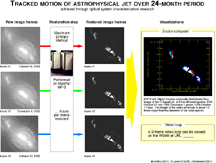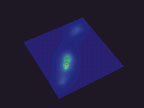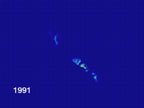
Characterization of Optical Systems Via Massively Parallel Architectures
Objective: The objective of this research is to show that our modeling of the Hubble Space Telescope (HST) Faint Object Camera (FOC) point-spread function (PSF) can produce scientifically useful results and thereby permit data mining of the observations that were taken before the HST was fixed in December 1993.
Approach: Model the noise-free PSF by means of Zernike polynomials in combination with primary and secondary mirror surface errors and phase retrieval algorithms that we have adapted to a parallel environment. In this effort, we have discovered that the focus term in the Zernike coefficients is the chief problem in accurately modeling PSF's at the same wavelength but separated in observing time. This finding is consistent with observations by HST instrument scientists that PSF's tended to change over the course of an orbit (i.e., the so-called breathing PSF phenomenon).
 Significance: In the ultraviolet (2550 Å, FWHM 236 Å), our restored data show sub-arc second changes in the morphology of the inner 5 arc seconds of the R Aquarii (R Aqr) jet over a two-year period. The emission detected is largely due to [O II] at 2470 Å. These data were taken with the HST/FOC when the primary mirror flaw was still affecting observations. Images of the R Aqr stellar jet were successfully restored to the original design resolution by completely characterizing the telescope-camera system with the aid of phase-retrieval techniques. Thus, a noise-free PSF was able to be calculated to effect the final restorations, which utilized the maximum entropy method (MEM). These results clearly show that the jet is expanding along the NE-SW axis with a prominent corkscrew-like structure evident in the stronger NE side of the jet. The corkscrew structure may be due to hydrodynamic or magnetohydrodynamic instabilities or simply due to the orbital motion of the hot companion and its accretion disk as they orbit the Mira primary star.
Significance: In the ultraviolet (2550 Å, FWHM 236 Å), our restored data show sub-arc second changes in the morphology of the inner 5 arc seconds of the R Aquarii (R Aqr) jet over a two-year period. The emission detected is largely due to [O II] at 2470 Å. These data were taken with the HST/FOC when the primary mirror flaw was still affecting observations. Images of the R Aqr stellar jet were successfully restored to the original design resolution by completely characterizing the telescope-camera system with the aid of phase-retrieval techniques. Thus, a noise-free PSF was able to be calculated to effect the final restorations, which utilized the maximum entropy method (MEM). These results clearly show that the jet is expanding along the NE-SW axis with a prominent corkscrew-like structure evident in the stronger NE side of the jet. The corkscrew structure may be due to hydrodynamic or magnetohydrodynamic instabilities or simply due to the orbital motion of the hot companion and its accretion disk as they orbit the Mira primary star.
A movie of the jet motion was produced that shows the 3 restored data sets rapidly displayed in sequence, showing the corkscrew structure moving to the left, away from the central source at about 300 km/s. The accompanying figure attempts to show this motion by the superposition of the three images. The stationary central object giving rise to the jet is apparently at the narrow end of the light-bulb-shaped structure, since all jet material seems to move away from this point. To the right of the central source are discrete parcels of material that can be seen to move to the right in the movie. Moreover, in the movie, the three restored data sets were volume-rendered and then faded in sequence at various viewing angles to show the snowplow effect of the jet motion and the narrow shock fronts that grow and decay as the jet material presumably interacts with the considerable ambient circumstellar material previously ejected.
Since this stellar source is one of the closest astrophysical jets at a distance of 250 parsecs (or 750 light-years), the motion detected in the ultraviolet may be the first that has been captured in a movie. Similar corkscrew-like structures have been seen in other stellar and cosmological jets, but the distances involved probably preclude as dramatic a presentation of motion as demonstrated in this work which has resulted in one publication: Hollis, J.M., Lyon, R. G., Dorband, J.E., and Feibelman, W.A., 1995: "Movie Showing Motion in the R Aqr Jet From October 1991 to October 1993 Using HST FOC Data," B.A.A.S., 27, 815.
Status/Plans: From this work we have shown that the archived HST data before the COSTAR fix can, in many cases, still be valuable scientifically. From our work to date, in principle, we can sample a calculated PSF at any desired resolution and generate imagery that exceeds the design resolution of the HST-FOC combination, and we intend to demonstrate this in the future. Further, we intend to aid other NASA spacecraft imaging experiments by applying this new, innovative technology.
Movies
 Maximum Entropy Image Restoration
Maximum Entropy Image Restoration
MPEG (1 Mbyte)
QuickTime (1 Mbyte)
This movie shows iterative restoration of a spherically aberrated HST Faint Object Camera image of the symbiotic star system R-Aquarii and its associated jet structure in the ultraviolet. The restoration algorithm is a Maximum Entropy with Maximum Likelihood Algorithm, developed under the OSCAR project, and runs on a MasPar MP-2 computer. A calculated point spread function based on telescope optical modeling is used as the blurring operator.
 Time Resolved Motion of R-Aquarii Jet Stucture Spanning 1991, 1992 and 1993
Time Resolved Motion of R-Aquarii Jet Stucture Spanning 1991, 1992 and 1993
MPEG (30 Kbytes)
QuickTime (31 Kbytes)
Three seperate HST Faint Object Camera UV images of the symbiotic star R-Aquarii system were restored with the Maximum Entropy with Convolutional Constraints Algorithm. The images span a 2-year period and show motion of the jet structure. The image scale is 8 x 11 arcseconds, the wavelength is 253 nanometers, and the coordinate system is Right Ascension and Declination.
 Time Resolved Motion of R-Aquarii Jet Stucture Spanning 1991, 1992 and 1993
Time Resolved Motion of R-Aquarii Jet Stucture Spanning 1991, 1992 and 1993
MPEG (28 Kbytes)
QuickTime (37 Kbytes)
Three seperate Hubble Space Telescope Faint Object Camera UV images of the symbiotic star R-Aquarii system were restored with the Maximum Entropy with Maximum Likelihood Constraints Algorithm. The images span a 2-year period and show motion of the jet structure. The image scale is 8 x 11 arcseconds, the wavelength is 253 nanometers, and the coordinate system is Right Ascension and Declination.
Points of Contact:
Dr. Jan M. Hollis
Dr. John Dorband
Richard G. Lyon/CESDIS
Goddard Space Flight Center
jan.m.hollis@gsfc.nasa.gov
dorband@nibbles.gsfc.nasa.gov
lyon@phase.gsfc.nasa.gov
URL: http://cesdis1.gsfc.nasa.gov/~lyon/
Table of Contents | Section Contents -- Applications Software | Subsection Contents -- Inhouse Computational Scientists
 Significance: In the ultraviolet (2550 Å, FWHM 236 Å), our restored data show sub-arc second changes in the morphology of the inner 5 arc seconds of the R Aquarii (R Aqr) jet over a two-year period. The emission detected is largely due to [O II] at 2470 Å. These data were taken with the HST/FOC when the primary mirror flaw was still affecting observations. Images of the R Aqr stellar jet were successfully restored to the original design resolution by completely characterizing the telescope-camera system with the aid of phase-retrieval techniques. Thus, a noise-free PSF was able to be calculated to effect the final restorations, which utilized the maximum entropy method (MEM). These results clearly show that the jet is expanding along the NE-SW axis with a prominent corkscrew-like structure evident in the stronger NE side of the jet. The corkscrew structure may be due to hydrodynamic or magnetohydrodynamic instabilities or simply due to the orbital motion of the hot companion and its accretion disk as they orbit the Mira primary star.
Significance: In the ultraviolet (2550 Å, FWHM 236 Å), our restored data show sub-arc second changes in the morphology of the inner 5 arc seconds of the R Aquarii (R Aqr) jet over a two-year period. The emission detected is largely due to [O II] at 2470 Å. These data were taken with the HST/FOC when the primary mirror flaw was still affecting observations. Images of the R Aqr stellar jet were successfully restored to the original design resolution by completely characterizing the telescope-camera system with the aid of phase-retrieval techniques. Thus, a noise-free PSF was able to be calculated to effect the final restorations, which utilized the maximum entropy method (MEM). These results clearly show that the jet is expanding along the NE-SW axis with a prominent corkscrew-like structure evident in the stronger NE side of the jet. The corkscrew structure may be due to hydrodynamic or magnetohydrodynamic instabilities or simply due to the orbital motion of the hot companion and its accretion disk as they orbit the Mira primary star.
 Maximum Entropy Image Restoration
Maximum Entropy Image Restoration Time Resolved Motion of R-Aquarii Jet Stucture Spanning 1991, 1992 and 1993
Time Resolved Motion of R-Aquarii Jet Stucture Spanning 1991, 1992 and 1993 Time Resolved Motion of R-Aquarii Jet Stucture Spanning 1991, 1992 and 1993
Time Resolved Motion of R-Aquarii Jet Stucture Spanning 1991, 1992 and 1993